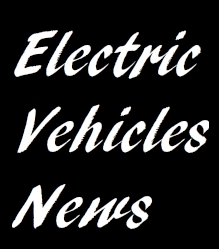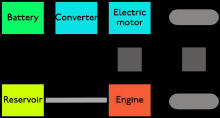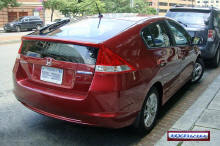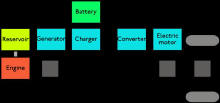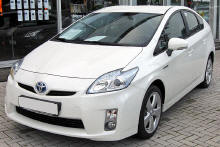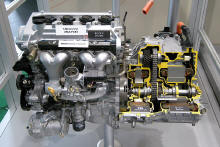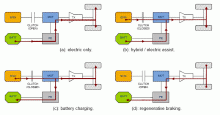Hybrid Vehicle Drivetrain
|
Hybrid vehicles are vehicles with two or more power sources in the drivetrain. There are many different types of hybrid vehicles, although only the gasoline-electric hybrid is currently commercially available. Hybrids are classified by the division of power between sources; two sources may operate in parallel to accelerate the vehicle, or the vehicle may be primarily driven by one source with the other only engaged during acceleration. Or in series-hybrids, only electricity is used to propel the vehicle via electric motors with a combustion generator set providing power to drive the vehicle and charge the battery bank. Current hybrids use both an internal combustion (IC) engine and a battery/electric drive system to improve fuel consumption, emission, and performance. Electrically-assisted pedal bicycles are a form of hybrid drive. Other combinations of energy storage and conversion are possible, although not yet in commercial production. Combustion-electric hybrids have larger battery sets than what a normal combustion engine only vehicle would have. Battery and supercapacitor technology is advancing. A potential advantage is that when these battery sets require renewing in the future, the newer battery sets will be potentially superior having higher energy storage giving greater range enhancing a vehicle. Types by drivetrain structureParallel hybridParallel hybrid systems, which are most commonly produced at present, have both an internal combustion engine (ICE) and an electric motor connected to a mechanical transmission. Most designs combine a large electrical generator and a motor into one unit, often located between the combustion engine and the transmission, replacing both the conventional starter motor and the alternator. To store power, a hybrid uses a large battery pack with a higher voltage than the normal automotive 12 volts. Accessories such as power steering and air conditioning are powered by electric motors instead of being attached to the combustion engine. This allows efficiency gains as the accessories can run at a constant speed, regardless of how fast the combustion engine is running.
Parallel hybrids can be categorized by the way the two sources of power are mechanically coupled. If they are joined at some axis truly in parallel, the speeds at this axis must be identical and the supplied torques add together. Most electric bicycles are in effect of this type. When only one of the two sources is being used, the other must either also rotate in an idling manner or be connected by a one-way clutch or freewheel. With cars it is more usual to join the two sources through a differential gear. Thus the torques supplied must be the same and the speeds add up, the exact ratio depending on the differential characteristics. When only one of the two sources is being used, the other must still supply a large part of the torque or be fitted with a reverse one-way clutch or automatic clamp.
Parallel hybrids can be further categorized depending upon how balanced the different portions are at providing motive power. In some cases, the combustion engine is the dominant portion (the electric motor turns on only when a boost is needed) and vice versa. Others can run with just the electric system operating. But because current parallel hybrids are unable to provide all-electric (ICE=OFF) propulsion, they are often categorized as mild hybrids. Because parallel hybrids can use a smaller battery pack as they rely more on regenerative braking and the internal combustion engine can also act a generator for supplemental recharging, they are more efficient on highway driving compared to urban stop-and-go conditions or city driving. Honda's Insight, Civic, and Accord hybrids are examples of production parallel hybrids. General Motors Parallel Hybrid Truck (PHT) and BAS Hybrids such as the Saturn VUE and Aura Greenline and Chevrolet Malibu hybrids are also considered as utilizing a parallel achitecture. Series-HybridSeries-hybrids have also been referred to as a Range-Extended Electric Vehicle (REEV) in order to emphasis that they are electric vehicles with a combustion engine assist. However, range extension can be accomplished with either series or parallel hybrid layouts.
Series-hybrid vehicles are driven only by electric traction. Unlike piston internal combustion engines, electric motors are efficient with exceptionally high power to weight ratios providing adequate torque over a wide speed range. Unlike combustion engines electric motors matched to the vehicle do not require a transmission between the engine and wheels shifting torque ratios. Transmissions add weight, bulk and sap power from the engine. Mechanical automatic shifting transmissions can be very complex. In a series-hybrid system, the combustion engine drives an electric generator instead of directly driving the wheels. The generator provides power for the driving electric motors. In short, a series-hybrid is simple, the vehicle is driven by electric motors with a generator set providing the electric power. This arrangement is not new being common in diesel-electric locomotives and ships. Ferdinand Porsche used this set up in the early 20th century in racing cars, effectively inventing the series-hybrid arrangement. Porsche named the system, System Mixt. A wheel hub motor arrangement, with a motor in each of the two front wheels was used, setting speed records. This arrangement was sometimes referred to as an electric transmission, as the electric generator and driving motor replaced a mechanical transmission. The vehicle could not move unless the internal combustion engine was running. The setup was never proved to be suitable for production cars being unable to synchronize the electric driving motors with the generator set power, resulting in higher fuel consumption. Technology has caught up, with modern computer engine management systems optimizing generator set running to match the power needed for the electric traction. Electric motors have become substantially smaller, lighter and efficient over the years. These advances have given the advantage to the electric transmission in normal operating conditions, over a conventional internal combustion engine and mechanical automatic transmission. One of the advantages is the smoother progressive ride with no stepped gear ratio changes. The electric transmission is currently viable in replacing the mechanical transmission. The Chevy Volt claims that without using energy from the battery running on gasoline only, fuel consumption is expected to be 50 mpg-US (4.7 L/100 km; 60 mpg-imp) on the city cycle of the EPA's test. For such a size of car this is notable fuel consumption. However, the modern series-hybrid vehicles takes the electric transmission to a higher plane adding greater value. There is a difference to an electric transmission. Modern series-hybrids contain:
The electric driving motor may run entirely fed by electricity from a large battery bank or via the generator turned by the internal combustion engine, or both. The battery bank may be charged by mains electricity reducing running costs as the range running under the electric motors only is extended. The vehicle conceptually resembles a Diesel-electric locomotive with the addition of large battery bank that may power the vehicle without the internal combustion engine running. The generator may simultaneously charge the battery bank and power the driving electric motor that moves the vehicle. The battery bank acts as an energy buffer. An advantage is that when the vehicle is stopped the combustion engine is switched off. When the vehicle moves it does so using the energy in the batteries. This reduces curbside emissions greatly in cities and towns. Vehicles at traffic lights, or in slow moving stop start traffic need not be polluting when stationary. In some arrangements when high levels of power are required, such as in vehicle acceleration, the electric driving motor draws electricity from both the batteries and the generator. With the Chevy Volt if the battery bank is depleted the vehicle may run entirely with electricity provided only from the generator. Some prototype vehicle designs such as the Volvo ReCharge and Ford F-Series pickup have electric motors in wheel hubs reducing the need for a differential saving weight, space and power being sapped by the differential. Series-hybrids can be also fitted with a supercapacitor or a flywheel to store regenerative braking energy, which can improve efficiency by clawing back energy that otherwise would be lost being dissipated via heat through the braking system. Because a series-hybrid omits a mechanical link between the combustion engine and the wheels, the engine can be run at a constant and efficient rate even as the vehicle changes speed. The vehicle speed and engine speed are not necessarily in synchronization. The engine can thus maintain an efficiency closer to the theoretical limit of 37%, rather than the current average of 20%. At low or mixed speeds this could result in ~50% increase in overall efficiency (19% vs 29%). However General Motors have designed the Chevy Volt's engine/generator set to operate between 1,200 and 4,000 revolutions per minute. The Lotus company has introduced an engine/generator set design that runs at two speeds, giving 15 kW of electrical power at 1,500 rpm and 35 kW at 3,500 rpm via the integrated electrical generator. As the requirements for the engine are not directly linked to vehicle speed, this gives greater scope for more efficient or alternative engine designs, such as a microturbine, rotary Atkinson cycle engine or a linear combustion engine. General Motors in 1999 made the experimental EV1 series hybrid using a turbine generator set. The turbine weighed 220 lb (99.8 kg), measured 20 inches (50.8 cm) in diameter by 22 inches (55.9 cm) long and ran between 100,000 and 140,000 rpm. Fuel consumption was 60 mpg-US (3.9 L/100 km; 72 mpg-imp) to 100 mpg-US (2.4 L/100 km; 120 mpg-imp) in hybrid mode. Depending on the driving conditions, a highway range of more than 390 miles (627.6 km) was achieved. The results were highly successful, and would have promised to be more successful if a smaller microturbine was used, yet the EV1 project was dropped. There are stages of operation: power from the combustion engine to the generator and then to the electric motor and, depending on the design, may also run through the generator and into the battery pack then to the electric motor further reducing efficiency (see illustration). Each transformation through each stage results in a loss of energy. However in normal vehicle operating conditions the energy buffer of the battery bank, which stores clawed back energy from braking and the optimum running of the combustion engine may raise overall operating efficiency, despite each stage being an energy loss. The engine to a mechanical automatic shifting transmission efficiency is approximately 70%-80%. A conventional mechanical clutch transmission, has an engine to transmission efficiency of 98%. In a series-hybrid vehicle, during long-distance high speed highway driving, the combustion engine will need to supply the majority of the energy, in which case a series-hybrid may be 20%-30% less efficient than a parallel hybrid. The use of a motor driving a wheel directly eliminates the conventional mechanical transmission elements: gearbox, transmission shafts and differential, and can sometimes eliminate flexible couplings. This offers great simplicity. If the motors are integrated into the wheels a disadvantage is that the unsprung mass increases and suspension responsiveness decreases which impacts ride performance and potentially safety. However the impact should be minimal if at all as electric motors in wheel hubs such as Hi-Pa Drive, may be very small and light having exceptionally high power to weight ratios. The braking mechanisms can be lighter as the wheel motors brake the vehicle. Light aluminum wheels may be used reducing the unsprung mass of the wheel assembly. Vehicle designs may be optimized to lower the centre of gravity having the heavy mechanicals and battery banks at floor level. If the motors are attached to the vehicle body, flexible couplings are still required. Advantages of individual wheel motors include simplified traction control and all wheel drive if required, allowing lower floors, which is useful for buses. Some 8x8 all-wheel drive military vehicles use individual wheel motors. Diesel-electric locomotives have used this concept for 70 years. In a typical road vehicle the whole series-hybrid power-transmission setup may be smaller and lighter than the equivalent conventional mechanical power-transmission setup which liberates space. As the combustion generator set only requires cables to the driving electric motors, there is greater flexibility in major component layout spread across the vehicle giving superior weight distribution and maximizing vehicle cabin space. This flexibility may lead to superior vehicle designs. In 1997 Toyota released the first series-hybrid bus sold in Japan. Meanwhile, GM hopes to introduce the Chevy Volt by 2011, aiming for an all-electric range of 40 miles and a price tag of around $40,000. Supercapacitors combined with a lithium ion battery bank have been used by AFS Trinity in a converted Saturn Vue SUV vehicle. Using supercapacitors they claim up to 150 mpg in a series-hybrid arrangement. Power-split or series-parallel hybridPower-split hybrid or series-parallel hybrid are parallel hybrids. They incorporate power-split devices allowing for power paths from the engine to the wheels that can be either mechanical or electrical. The main principle behind this system is the decoupling of the power supplied by the engine (or other primary source) from the power demanded by the driver.
A combustion engine's torque is minimal at lower RPMs and, in a conventional vehicle, a larger engine is necessary for acceleration from standstill. The larger engine, however, has more power than needed for steady speed cruising. An electric motor, on the other hand, exhibits maximum torque at standstill and is well-suited to complement the engine's torque deficiency at low RPMs. In a power-split hybrid, a smaller, less flexible, and highly efficient engine can be used. The conventional Otto cycle (higher power density, more low-rpm torque, lower fuel efficiency) is often also modified to a Miller cycle or Atkinson cycle (lower power density, less low-rpm torque, higher fuel efficiency). The smaller engine using a more efficient cycle contributes significantly to the higher overall efficiency of the vehicle. Interesting variations of the simple design (pictured at right)
found, for
The Toyota Hybrid System THS /
Hybrid Synergy Drive has a single power-split device (incorporated
as a single 3 shaft planetary gearset) and can be classified as an
Input-Split, since the power of the engine is
General Motors, BMW, and DaimlerChrysler have developed in collaboration a system named "Two-Mode Hybrid" as part of the Global Hybrid Cooperation. The technology was released in the fall of 2007 on the Chevrolet Tahoe Hybrid. The system was also featured on the GMC Graphite SUV concept vehicle at the 2005 North American International Auto Show in Detroit. BYD Auto's F3DM sedan is a series-parallel plug-in hybrid automobile, which went on sale in China on December 15, 2008. The Two-Mode Hybrid name is intended to emphasize the drivetrain's ability to operate in all-electric (Mode 1) as well as hybrid (Mode 2) modes. The design, however, allows for operation in more than two modes; two power-split modes are available along with several fixed gear (essentially parallel hybrid) regimes. For this reason, the design can be referred to as a multi-regime design. The Two-Mode Hybrid powertrain design can be classified as a compound-split design, since the addition of four clutches within the transmission allows for multiple configurations of engine power-splitting. In addition to the clutches, this transmission also has a second planetary gearset. The objective of the design is to vary the percentage of mechanically vs. electrically transmitted power to cope both with low-speed and high-speed operating conditions. This enables smaller motors to do the job of larger motors when compared to single-mode systems. The four fixed gears enable the Two-Mode Hybrid to function like a conventional parallel hybrid under high continuous power regions such as sustained high speed cruising or trailer towing. Full electric boost is available in fixed gear modes. Types by degree of hybridizationFull HybridsA full hybrid, sometimes also called a strong hybrid, is a vehicle that can run on just the engine, just the batteries, or a combination of both. The BYDF3DM,Toyota Prius, Ford Escape Hybrid/Mercury Mariner Hybrid, as wellas the General Motors 2-mode hybrid trucks and SUVs, are examples of this type of hybridization as they are able to be propelled on battery power alone. A large, high-capacity battery pack is needed for battery-only operation. These vehicles have a split power path that allows more flexibility in the drivetrain by interconverting mechanical and electrical power, at some cost in complexity. To balance the forces from each portion, the vehicles use a differential-style linkage between the engine and motor connected to the head end of the transmission. The Toyota brand name for this technology is Hybrid Synergy Drive, which is being used in the Prius, the Highlander Hybrid SUV, and the Camry Hybrid. A computer oversees operation of the entire system, determining which half should be running, or if both should be in use. The operation of the Prius can be divided into six distinct regimes.
The hybrid drivetrain of the Prius, in combination with aerodynamics and optimizations in the engine itself to reduce drag, results in 80%–100% gains in fuel economy compared to four-door conventional cars of similar weight and size. Mild HybridsMild hybrids are essentially conventional vehicles with some degree of hybrid hardware, but with limited hybrid feature utilization. Typically they are a parallel system with start-stop only or possibly in combination with modest levels of engine assist or regenerative braking features. Unlike full hybrids, Mild hybrids generally cannot provide provide ICE-OFF all-electric (EV) propulsion. Mild hybrids like the General Motors 2004-07 Parallel Hybrid Truck (PHT) and the Honda Eco-Assist hybrids are equipped with a 3-phase electric motor motor mounted within the bell-housing between the engine and transmission, allowing the engine to be turned off whenever the truck is coasting, braking, or stopped, yet restart quickly when required. Accessories can continue to run on electrical power while the engine is off, and as in other hybrid designs, the motor is used for regenerative braking to recapture energy. The large electric motor is used to spin up the engine to operating rpm speeds before injecting any fuel. The 2004-07 Chevrolet Silverado PHT, was a full-size pickup truck. Chevrolet was able to get a 10% improvement on the Silverado's fuel efficiency by shutting down and restarting the engine on demand and using regenerative braking. However the electrical motor was not used to provide propulsion or assist, rather the electrical energy was used to drive accessories like the A/C and power steering.The GM PHT used a 42 volt systems via a pack comprised three 12V vented lead acid batteries connected in serie(36V total) to supply the power needed for the startup motor, as well as to compensate for the increasing number of electronic accessories on modern vehicles. General Motors followed the parallel hybrid truck with their BAS Hybrid system, another mild hybrid implementation officially released on the 2007 Saturn Vue Green Line. For its "start-stop" functionality, it operates similarly to the system in the Silverado, although via a belted connection to the motor/generator unit. However the GM BAS Hybridsystem has broader hybrid functionality as the electric motor can also provide modest assist under acceleration and during steady driving, and craptures energy during regenerative (blended) braking. The BAS Hybrid can result in as much as a 27% improvement in combined fuel efficiency as noted by the EPA in testing of the 2009 Saturn VUE. The BAS Hybrid system can also be found on the 2008-09 Saturn Aura and the 2008-2010 Chevrolet Malibu hybrids. Another way to provide for shutting off a car's engine when it is stopped, then immediately restarting it when it's time to go, is by employing a static start engine. Such an engine requires no starter motor, but employs sensors to determine the exact position of each piston, then precisely timing the injection and ignition of fuel to turn over the engine. Mild hybrids are sometimes called Power assist hybrids' as they use the engine for primary power, with a torque-boosting electric motor also connected to a largely conventional powertrain. The electric motor, mounted between the engine and transmission, is essentially a very large starter motor, which operates not only when the engine needs to be turned over, but also when the driver "steps on the gas" and requires extra power. The electric motor may also be used to re-start the combustion engine, deriving the same benefits from shutting down the main engine at idle, while the enhanced battery system is used to power accessories. Honda's hybrids including the Insight use this design, leveraging their reputation for design of small, efficient gasoline engines; their system is dubbed Integrated Motor Assist (IMA). Assist hybrids differ fundamentally from full hybrids in that propulsion cannot be accomplished on electric power alone. However, since the amount of electrical power needed is much smaller, the size of the system is reduced. Starting with the 2006 Civic Hybrid, the IMA system now can propel the vehicle solely on electric power during medium speed cruising. A variation on this type of hybrid is the Saturn Vue Green Line BAS Hybrid system that uses a smaller electric motor (mounted to the side of the engine), and battery pack than the Honda IMA, but functions similarly. Another variation on this type is Mazda's e-4WD system, offered on the Mazda Demio sold in Japan. This front-wheel drive vehicle has an electric motor which can drive the rear wheels when extra traction is needed. The system is entirely disengaged in all other driving conditions, so it does not directly enhance performance or economy but allows the use of a smaller and more economical engine relative to total performance. Ford has dubbed Honda's hybrids "mild" in their advertising for the Escape Hybrid, arguing that the Escape's full hybrid design is more efficient. Plug-in hybridA plug-in hybrid electric vehicle (PHEV) has two defining characteristics: 1) it can be plugged in to an electrical outlet to be charged and (2) has some range that can be traveled on the energy it stored while plugged in. They are full hybrid, able to run in electric-only mode, with larger batteries and the ability to recharge from the electric power grid. And can be parallel or series hybrid designs. They are also called gas-optional, or griddable hybrids. Their main benefit is that they can be gasoline-independent for daily commuting, but also have the extended range of a hybrid for long trips. They can also be multi-fuel, with the electric power supplemented by diesel, biodiesel, or hydrogen. The Electric Power Research Institute's research indicates a lower total cost of ownership for PHEVs due to reduced service costs and gradually improving batteries. The "well-to-wheel" efficiency and emissions of PHEVs compared to gasoline hybrids depends on the energy sources of the grid (the US grid is 50% coal; California's grid is primarily natural gas, hydroelectric power, and wind power). Particular interest in PHEVs is in California where a "million solar homes" initiative is under way, and global warming legislation has been enacted. Prototypes of PHEVs, with larger battery packs that can be recharged from the power grid, have been built in the U.S., notably at Prof. Andy Frank's Hybrid Center at University of California, Davis and one production PHEV, the Renault Kangoo, went on sale in France in 2003. DaimlerChrysler is currently building PHEVs based on the Mercedes-Benz Sprinter van. Light Trucks are also offered by Micro-Vett SPA the so called Daily Bimodale. The California Cars Initiative has converted the '04 and newer Toyota Prius to become a prototype of what it calls the PRIUS+. With the addition of 300 lb of lead-acid batteries, the PRIUS+ achieves roughly double the gasoline mileage of a standard Prius and can make trips of up to 10 miles using only electric power. Chinese battery manufacturer and automaker BYD Auto released the F3DM PHEV-62 (PHEV-100 km) hatchback to the Chinese fleet market on December 15, 2008. General Motors expects to launch the 2011 Chevrolet Volt series plug-in (PHEV-40) by November 2010. Types by nature of the power sourceElectric-internal combustion engine hybridThere are many ways to create an electric-Internal Combustion Engine (ICE) hybrid. The variety of electric-ICE designs can be differentiated by how the electric and combustion portions of the powertrain connect, at what times each portion is in operation, and what percent of the power is provided by each hybrid component. Two major categories are series hybrids and parallel hybrids, though parallel designs are most common today. Most hybrids, no matter the specific type, use regenerative braking to recover energy when slowing down the vehicle. This simply involves driving a motor so it acts as a generator. Many designs also shut off the internal combustion engine when it is not needed in order to save energy. That concept is not unique to hybrids; Subaru pioneered this feature in the early 1980s, and the Volkswagen Lupo 3L is one example of a conventional vehicle that shuts off its engine when at a stop. Some provision must be made, however, for accessories such as air conditioning which are normally driven by the engine. Furthermore, the lubrication systems of internal combustion engines are inherently least effective immediately after the engine starts; since it is upon startup that the majority of engine wear occurs, the frequent starting and stopping of such systems reduce the lifespan of the engine considerably. Also, start and stop cycles may reduce the engine's ability to operate at its optimum temperature, thus reducing the engine's efficiency. Electric-fuel cell hybridFuel cell vehicles are often fitted with a battery or supercapacitor to deliver peak acceleration power and to reduce the size and power constraints on the fuel cell (and thus its cost); this is effectively also a series hybrid configuration.
Hydraulic-internal combustion engine hybridA hydraulic hybrid vehicle uses hydraulic and mechanical components instead of electrical ones. A variable displacement pump replaces the motor/generator, and a hydraulic accumulator (which stores energy as highly compressed nitrogen gas) replaces the batteries. The hydraulic accumulator, which is essentially a pressure tank, is potentially cheaper and more durable than batteries. Hydraulic hybrid technology was originally developed by Volvo Flygmotor and was used experimentally in buses from the early 1980s and is still an active area. Initial concept involved a giant flywheel for storage connected to a hydrostatic transmission, but it was later changed to a simpler system using a hydraulic accumulator connected to a hydraulic pump/motor. It is also being actively developed by Eaton and several other companies, primarily in heavy vehicles like buses, trucks and military vehicles. An example is the Ford F-350 Mighty Tonka concept truck shown in 2002. It features an Eaton system that can accelerate the truck up to highway speeds. The energy recovery rate is higher and therefore the system is more efficient than battery charged hybrids, demonstrating a 60% to 70% increase in economy in EPA testing. Under tests done by the EPA, a hydraulic hybrid Ford Expedition returned 32 MPG City, and 22MPG highway. UPS currently has two trucks in service with this technology. While the system has faster and more efficient charge/discharge cycling, the accumulator size and pressure dictates total energy capacity, and requires more space than a battery. Internal combustion engine-pneumatic hybridCompressed air can also power a hybrid car with a gasoline compressor to provide the power. Motor Development International in France is developing such air-powered cars. A team led by Tsu-Chin Tsao, a UCLA mechanical and aerospace engineering professor, is collaborating with engineers from Ford to get Pneumatic hybrid technology up and running. The system is similar to that of a hybrid-electric vehicle in that braking energy is harnessed and stored to assist the engine as needed during acceleration. Human power and environmental power hybridsMany land and water vehicles use human power combined with a further power source. Common are parallel hybrids, e.g. a boat being rowed and also having a sail set, or motorized bicycles, or a human-electric hybrid vehicle such as the Twike. Also some series hybrids exist, see in hybrid vehicle. Such vehicles can be tribrid vehicles, combining at the same time three power sources e.g. from on-board solar cells, from grid-charged batteries, and from pedals. Solar Photovoltaics (PV)To date it has not been mentioned or done, the integration of photovoltaics with a Hybrid car as a way to extend the distance a car can travel on electric power alone or as a way to help keep batteries charged or to recharge them when a car is parked, or for that matter, standing at a traffic light. With the advent of thin-film photovoltaics the cost of integrating them could become negligible in mass production. (There are no citations for this as it is not being done or even considered at this time. This has been included to hopefully get people to think about adding Solar PV in car designs in the very near future. Richard Boettner) Hybrid vehicle operation modesHybrid vehicles can be used in different modes. The figure shows some typical modes for a parallel hybrid configuration.
|
